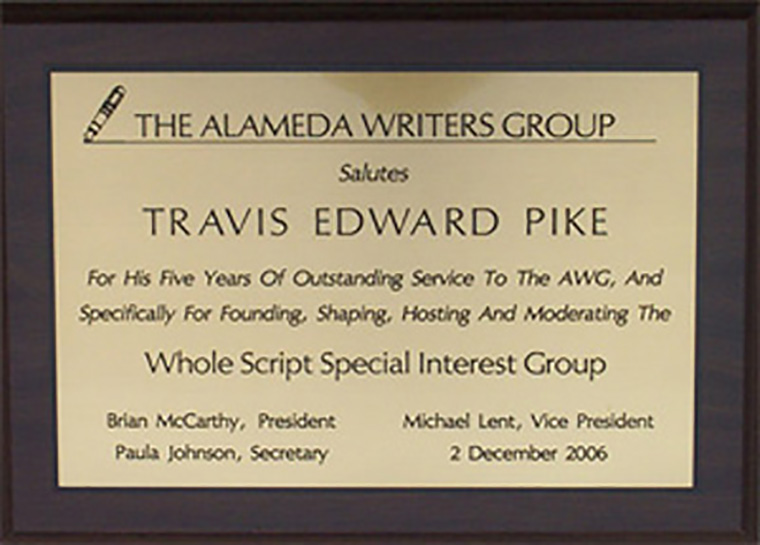 |
ALAMEDA WRITERS GROUP |  |
|---|
 |
ALAMEDA WRITERS GROUP |  |
|---|

The membership of the AWG included writers of every stripe; fiction and non-fiction, poets, authors, journalists, playwrights, screenwriters, and writers for episodic television, but the screenwriters group, in order to allow more member participation, limited writers to presenting no more than ten pages at a time, but for newcomer Travis Edward Pike, former Director of Production at Cine-Media International, that was inadequate. Structure, plot and character development, not formatting, grammar and spelling were his focus. In the December 2001 Alameda Writers Group annual election of officers, having only been a member for a little over half a year, Travis ran for vice president, and much to his surprise, he was elected. His goal as VP was to establish a Whole Script SIG, based on the New Playwrights Foundation model in which one complete stage play, screenplay, or teleplay screen was read and critiqued at each meeting, and he composed guidelines for the AWG SIG, that became, in its first year, one of the most popular and useful SIGs the AWG offered, and Pike's guidelines have since been adopted by several other writers' groups. |
SUBMISSION GUIDELINES |
||
The analyytical skills we hope to foster in the Whole Screenplay SIG should stand you in good stead when you are called upon to critiue a screenplay, finished motion picture, or your own work prior to submission. The parameters by which one analyzes and critiques a screenplay do not change much from genre to genre. In critiquing tonight's screenplay, please ask yourself: Are the characters well-drawn? a. Is the dialogue believable/appropriate for the character/genre? b. Does each character have a unique voice (or do they all share the writer's voice?) c. Do you care about them? d. Are their actions well-motivated? e. Do the antagonist and protagonist have spines? ( A theatrical term. If you don't know what it means, please ask.) f. Are their beats onsistant with their spines? (Likewise.) Is the screenplay structurally sound? a. In Act One, is the main character's problem made clear? b. In Act two, are the complications believable (within the genre)? c. Do the complications move plot/character development forward? In Act Three, is the main character's problem resolved? Is the story Well Developed? a. Does it hold your interest? b. Does it move (is it a filmscript or a book -- action or talk)? c. Was there anything jarring and/or out of place that interfered with your willing suspension of disbelief? d. If so, what do you think might be done to correct it? You may, of course, address issues of spelling, form, punctuation, whitespace, and readability, but keep in mind that such issues, while important, are only footnotes to this kind of critique. CRITIQUE GUIDELINES Tell Travis you have a screenplay ready and he will schedule it. (You must be a paid-up member of the AWG. You must have participated in three Whole Screenplay SIGS to be eligible to submit your screenplay. Why? 1. It affors you opportunities to participate and see how the Whoe,Cript SIG operates, before submitting your screenplay to our scrutiny. 2. It gives you an opportnity to get to know the talent in the SIG, before you have to cast members to read parts in your screeplay. (Some of us read better than others. Some would be better in specific roles.) 3. You will hear critiques offered by the members of the SIG which will help you evaluate the criticism you receive. (Whole Screenplay SIG cricism is meant to be helpful to you, but you may find some critics more perceptive, more experienced, or more helpful than others. You owe it to yourself to get to know and be able to evaluate your critics. 4. It's only fair. We will give you the benefit of our best judgment. By participating in at least three SIGs, the group will benefit from your critique of screeenplays submitted by others. 5. Finally, as you participate in the process, you may learn new tricks or critical techniques that you may wish to apply to your own work before submitting it to the group. Notwithsrtanding the Sturm and Drang of exposing your love child to our sometimes less than tender mercies, there are some costs involved. We use evites to try to assure that you will have enough screenplays on hand so that all the responding readers may participate. Copies can bhe expensive. 15-18 copies plus front and back covers,collated, punched and assembled with brass fasteners can run to $140.00, depending on you page count. Also, the person whose screenpklay is being read is responsible for the beverages and snacks at the meeting. Otherworldf Cottage willprovide coffee, tea, milk and sugar. You are expected to provide whatever juices, soft drinks, cupcakes, cake, pie or cookies yo choose to offer for the session. (If you need help, ask!) Thank you for your participation. I hope you will enjoy this Whole Screenplay SIG and consider participating regularly. |
| BACK | HOME PAGE | NEXT |
|---|